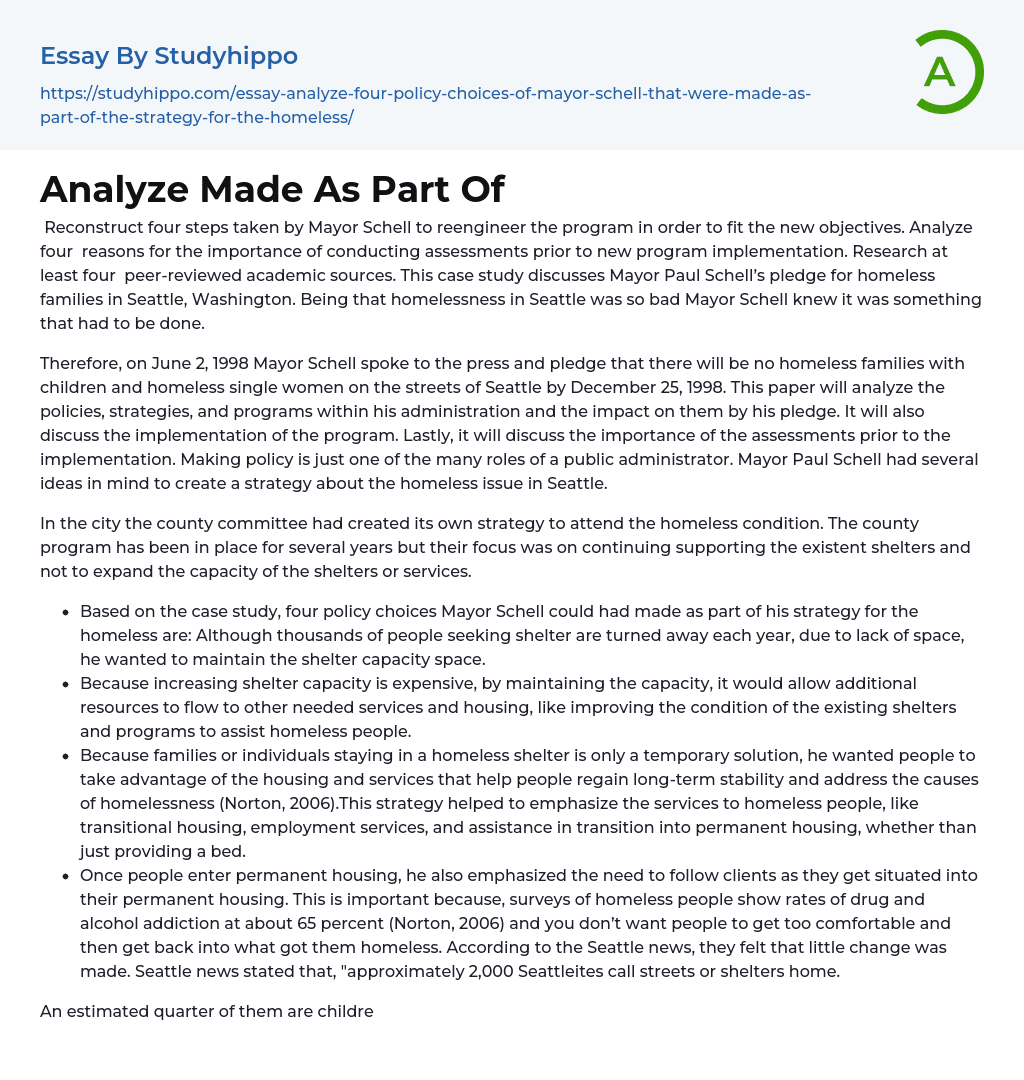The text focuses on Mayor Paul Schell's endeavor to revamp the program and adapt it to new goals. It highlights four actions taken by the mayor in this process. Furthermore, it emphasizes the importance of conducting evaluations before implementing a new program and provides four reasons backing up this significance. The case study centers around Mayor Schell's commitment to aiding homeless families in Seattle, Washington, considering the seriousness of the problem within the city.
On June 2, 1998, Mayor Schell made a promise to the press that he would ensure that no homeless families with children and single homeless women would be found on Seattle streets by December 25, 1998. This analysis will explore the policies, strategies, and programs implemented by Mayor Schell's administration and their impact on fulfilling his commitment. Additionally, we will discuss progra
...m implementation and the importance of conducting assessments prior to execution. It is crucial to acknowledge that policy-making is only one aspect of a public administrator's duties, and Mayor Paul Schell had numerous ideas for addressing homelessness in Seattle.
In order to address homelessness, the city's county committee has implemented a unique approach. Rather than simply expanding existing shelters or their services, the county program aims to provide ongoing support and aid to these establishments.
- Based on the case study, four policy choices Mayor Schell could had made as part of his strategy for the homeless are: Although thousands of people seeking shelter are turned away each year, due to lack of space, he wanted to maintain the shelter capacity space.
- Because increasing shelter capacity is expensive
by maintaining the capacity, it would allow additional resources to flow to other needed services and housing, like improving the condition of the existing shelters and programs to assist homeless people.
Approximately a quarter of the homeless population consists of children. Activists point out that although the city's emergency rent subsidies are appreciated, they fail to address the ongoing homelessness faced by these families. Painter concludes the case study by considering the steps needed to eradicate homelessness completely and questions who is responsible for tracking and determining this number.
- Homelessness In America essays
- Business Law essays
- Contract essays
- Consumer Protection essays
- Property essays
- Ownership essays
- Agreement essays
- Common Law essays
- Contract Law essays
- Justice essays
- Security essays
- Tort Law essays
- United States Constitution essays
- Crime essays
- Lawsuit essays
- Treaty essays
- Family Law essays
- Marijuana Legalization essays
- Constitution essays
- War on Drugs essays
- Court essays
- Jury essays
- Police essays
- Protection essays
- Community Policing essays
- Criminal Law essays
- Judge essays
- Lawyer essays
- Employment Law essays
- Copyright Infringement essays
- Injustice essays
- Intellectual Property essays
- Breach Of Contract essays
- Jurisprudence essays
- Social Injustice essays
- Juvenile Justice essays
- Internet Privacy essays
- Cyber Security essays
- Bill Of Rights essays
- Civil Liberties essays
- First Amendment To The United States Constitution essays
- Fourth Amendment To The United States Constitution essays
- Second amendment essays
- Animal Cruelty essays
- Law Enforcement essays
- Juvenile Justice System essays
- Surveillance essays
- Forensic Science essays
- Crime Prevention essays
- Criminal Justice essays




